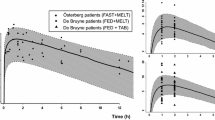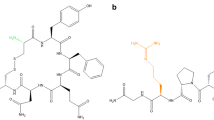Abstract
Desmopressin 120 μg oral lyophilisate and 200 μg tablet are considered bioequivalent, based on extrapolation of studies in a limited number of adults and on one dose-finding study of desmopressin oral lyophilisate in children. However, no comparative pharmacokinetic study in children was executed confirming this statement. No data are available on the influence of food intake on the bioavailability of desmopressin tablet in a pediatric setting, although studies in adults have documented that food intake results in a significantly lower desmopressin plasma concentration. In this study, we analyzed plasma concentrations of desmopressin oral lyophilisate and tablet with concomitant food intake. Twenty-three children with monosymptomatic nocturnal enuresis (mean age, 12.7 years) were recruited. Two tests were performed on two separate days in identical conditions with a standardized food and fluid intake. Desmopressin was administered as desmopressin tablet or desmopressin oral lyophilisate immediately after a meal. Desmopressin plasma concentration was measured at 1 h, 2 h, and 6 h postdosing. No significant difference in plasma concentration of 120 μg desmopressin oral lyophilisate and 200 μg tablet was demonstrated, even with concomitant food intake. A significant difference in variability was found, identifying a smaller variance for desmopressin oral lyophilisate plasma concentrations at all time points. This study demonstrates comparable plasma levels for desmopressin oral lyophilisate, despite the lower dose. The dosage for desmopressin oral lyophilisate is more predictable due to the significantly smaller variance. Therefore, desmopressin oral lyophilisate seems more suitable, especially in the younger age group for which time interval between dinner and drug administration is limited.



Similar content being viewed by others
Abbreviations
- dDAVP:
-
1-deamino-8-d-Arginine vasopressin
- EMA:
-
European Medicines Agency
- ICH:
-
International Conference on Harmonization
- LC-MS/MS:
-
Liquid chromatography coupled with tandem mass spectrometry
- PIP:
-
Pediatric investigational plan
- PK:
-
Pharmacokinetics
- PD:
-
Pharmacodynamics
- PUMA:
-
Pediatric use marketing authorization
References
(EMA), E. M. A. (2000). Note for guidance on the investigation of bioavailability and bioequivalence
Agency, E. M. (2006). REGULATION (EC) No 1901/2006 OF THE EUROPEAN PARLIAMENT AND OF THE COUNCIL of 12 december 2006. Retrieved January 29, 2013, from http://ec.europa.eu/health/files/eudralex/vol-1/reg_2006_1901/reg_2006_1901_en.pdf. Accessed 29 Jan 2013
Antosova Z, Mackova M, Kral V, Macek T (2009) Therapeutic application of peptides and proteins: parenteral forever? Trends Biotechnol 27(11):628–635
Baylis PH, Cheetham T (1998) Diabetes insipidus. Arch Dis Child 79(1):84–89
De Cock RF, Piana C, Krekels EH, Danhof M, Allegaert K, Knibbe CA (2011) The role of population PK-PD modelling in paediatric clinical research. Eur J Clin Pharmacol 67(Suppl 1):5–16
De Guchtenaere A, Van Herzeele C, Raes A, Dehoorne J, Hoebeke P, Van Laecke E, Walle JV (2011) Oral lyophylizate formulation of desmopressin: superior pharmacodynamics compared to tablet due to low food interaction. J Urol 185(6):2308–2313
Dehoorne JL, Raes AM, van Laecke E, Hoebeke P, Vande Walle JG (2006) Desmopressin toxicity due to prolonged half-life in 18 patients with nocturnal enuresis. J Urol 176(2):754–757, discussion 757–758
Glazener CM, Evans JH (2002) Desmopressin for nocturnal enuresis in children. Cochrane Database Syst Rev 3, CD002112
Hjalmas K, Arnold T, Bower W, Caione P, Chiozza LM, von Gontard A, Yeung CK (2004) Nocturnal enuresis: an international evidence based management strategy. J Urol 171(6 Pt 2):2545–2561
Kearns GL, Abdel-Rahman SM, Alander SW, Blowey DL, Leeder JS, Kauffman RE (2003) Developmental pharmacology—drug disposition, action, and therapy in infants and children. N Engl J Med 349(12):1157–1167
Neveus T, von Gontard A, Hoebeke P, Hjalmas K, Bauer S, Bower W, Djurhuus JC (2006) The standardization of terminology of lower urinary tract function in children and adolescents: report from the Standardisation Committee of the International Children's Continence Society. J Urol 176(1):314–324
Norgaard JP, Pedersen EB, Djurhuus JC (1985) Diurnal anti-diuretic-hormone levels in enuretics. J Urol 134(5):1029–1031
Osterberg O, Balchen T, Riis A, Senderovitz T (2006) Pharmacokinetics of desmopressin in children and adults using a new oral lyophilisate. Arch Dis Child 91:A31–A34
Osterberg O, Savic RM, Karlsson MO, Simonsson US, Norgaard JP, Walle JV, Agerso H (2006) Pharmacokinetics of desmopressin administrated as an oral lyophilisate dosage form in children with primary nocturnal enuresis and healthy adults. J Clin Pharmacol 46(10):1204–1211
Rittig S, Jensen AR, Jensen KT, Pederson EB (1998) Effect of fod intake on the pharmacokinetics and antidiuretic activity of oral desmopressin (dDAVP) in hydrated normal subject. Clin Endocrinol (Oxf) 48:235–241
Schulman SL, Stokes A, Salzman PM (2001) The efficacy and safety of oral desmopressin in children with primary nocturnal enuresis. J Urol 166(6):2427–2431
Theunis M, Van Hoecke E, Paesbrugge S, Hoebeke P, Vande Walle J (2002) Self-image and performance in children with nocturnal enuresis. Eur Urol 41(6):660–667, discussion 667
Van de Walle J, Van Herzeele C, Raes A (2010) Is there still a role for desmopressin in children with primary monosymptomatic nocturnal enuresis?: a focus on safety issues. Drug Saf : Int J Med Toxicol Drug Exp 33(4):261–271
van Kerrebroeck PN, Norgaard JP (2009) Desmopressin for the treatment of primary nocturnal enuresis. Pediatr Heal 3(4):317–327
Vande Walle JG, Bogaert GA, Mattsson S, Schurmans T, Hoebeke P, Deboe V, Norgaard JP (2006) A new fast-melting oral formulation of desmopressin: a pharmacodynamic study in children with primary nocturnal enuresis. BJU Int 97(3):603–609
Vande Walle J, Stockner M, Raes A, Norgaard JP (2007) Desmopressin 30 years in clinical use: a safety review. Curr Drug Saf 2(3):232–238
Acknowledgments
This study was investigator-driven and was in part supported by an unrestricted grant from Ferring International. Pauline De Bruyne has received an independant grant for Strategic Basic Research of the Agency for Innovation by Science and Technology in Flanders (IWT).
Author information
Authors and Affiliations
Corresponding author
Rights and permissions
About this article
Cite this article
De Bruyne, P., De Guchtenaere, A., Van Herzeele, C. et al. Pharmacokinetics of desmopressin administered as tablet and oral lyophilisate formulation in children with monosymptomatic nocturnal enuresis. Eur J Pediatr 173, 223–228 (2014). https://doi.org/10.1007/s00431-013-2108-2
Received:
Accepted:
Published:
Issue Date:
DOI: https://doi.org/10.1007/s00431-013-2108-2




